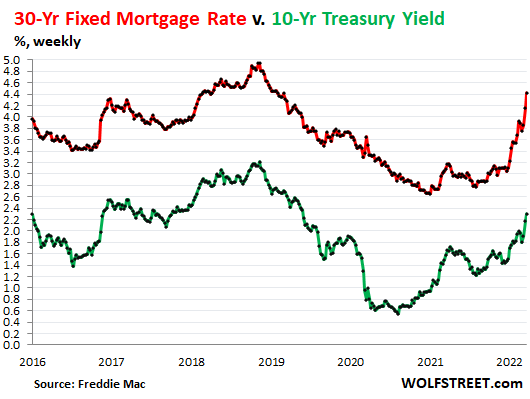Mortgage Rates Are Rising Much Faster than Treasury Yields. What’s the Deal?
By Wolf Richter
Is this spread heading to what happened in the 1970s and 1980s when the Fed battled blow-out inflation?
The average 30-year fixed mortgage rate tracks the 10-year Treasury yield, running roughly in parallel but higher. It tracks the 10-year yield because the average 30-year mortgage gets paid off in just under 10 years, either through the sale of the home or through a refi. But they don’t move in lockstep, and the difference between the two – the spread – has been widening sharply, with mortgage rates suddenly rising much faster than the 10-year yield.
The US Treasury 10-year yield has shot up since the Fed made its infamous “pivot” in the fall of 2021, from willfully ignoring and assiduously brushing off the incredibly spiking inflation to actually acknowledging, even if tepidly at first, its existence and persistence.
Back in August 2021, the 10-year yield was still at around 1.3%. Today it’s 2.34%, having gained 1.03 percentage points in seven months. Over the same period, the average 30-year fixed mortgage rate, as tracked by Freddie Mac, jumped by 1.55 percentage points, from 2.87% to 4.42%:
The chart above shows what happened during the March 2020 chaos, when the Fed cut its policy rates to near 0% and announced a huge QE program which caused the 10-year Treasury yield (green line) to plunge, while mortgage rates just continued their methodical decline that lasted through December 2020.
That decline in mortgage rates was kicked off in late November 2018, when Powell, getting hammered on a daily basis by Trump, caved and communicated that the Fed would soon stop tightening.
*****
Continue reading this article at Wolf Street.
This article is courtesy of ThePricklyPear.org, an online voice for citizen journalists to express the principles of limited government and personal liberty to the public, to policy makers, and to political activists. Please visit ThePricklyPear.org for more great content.


